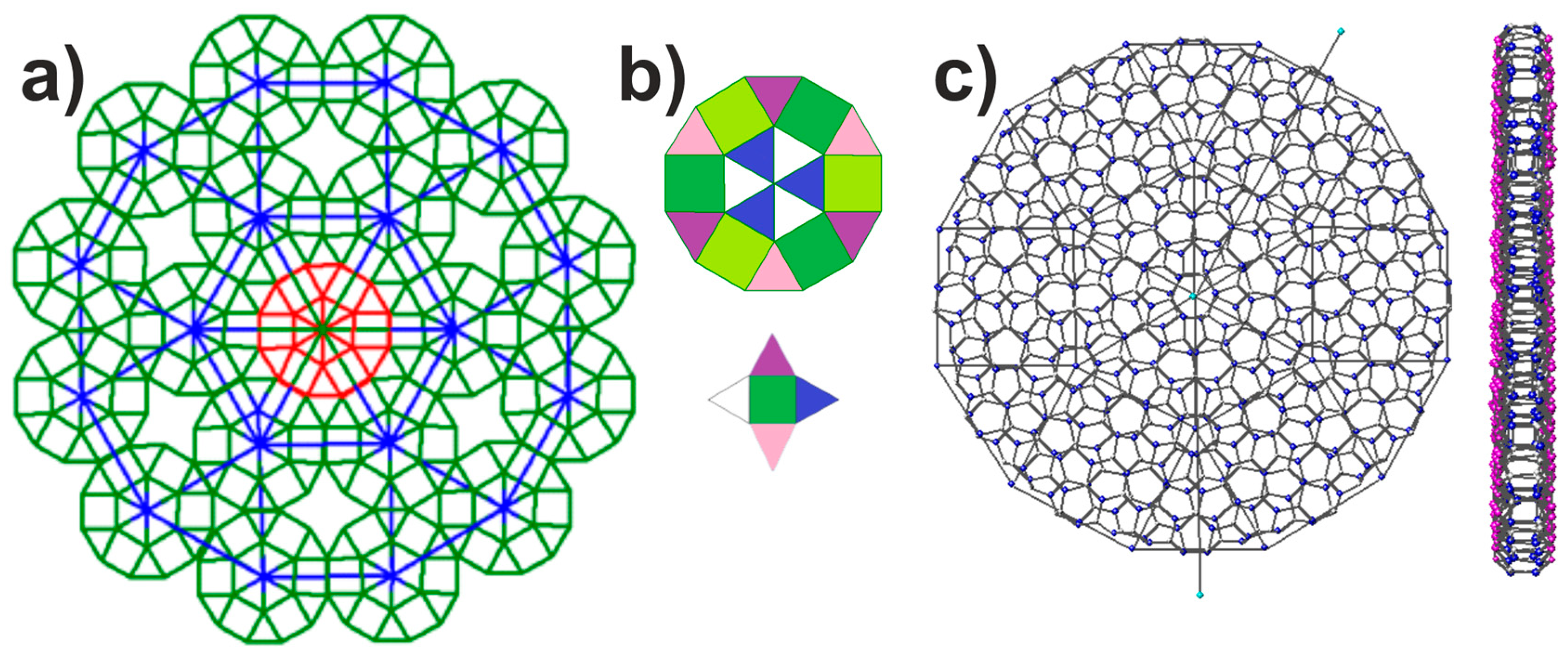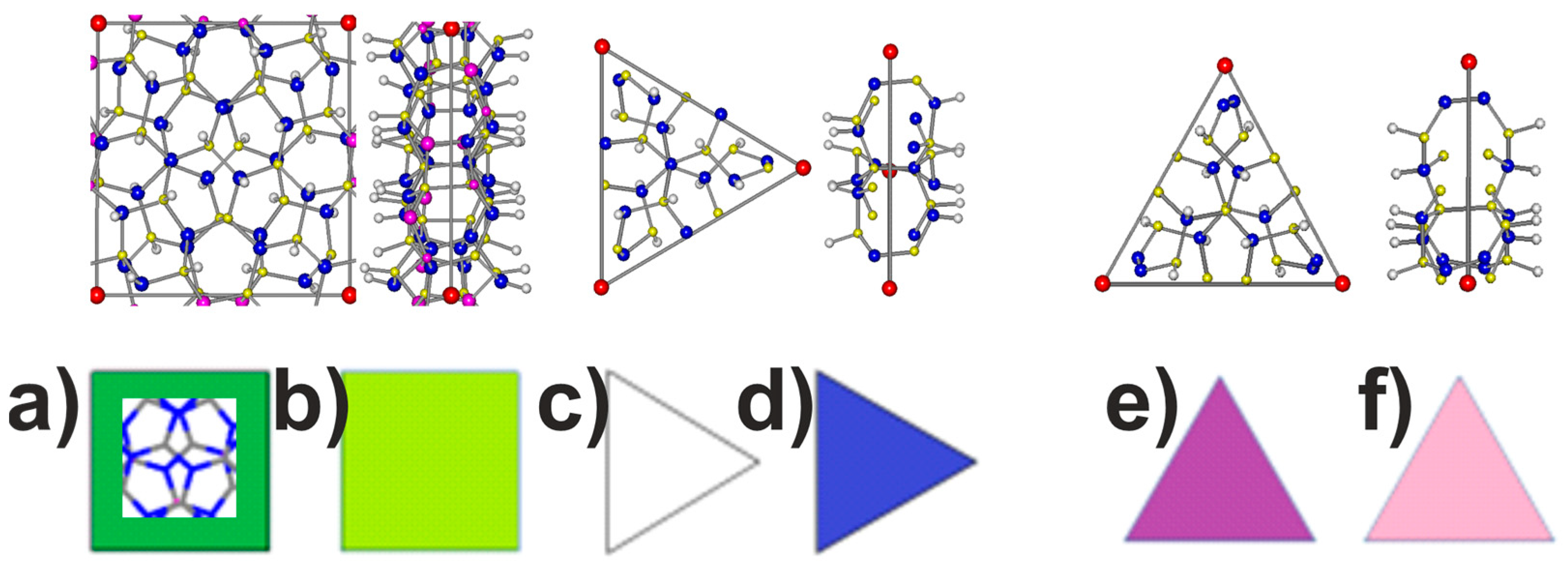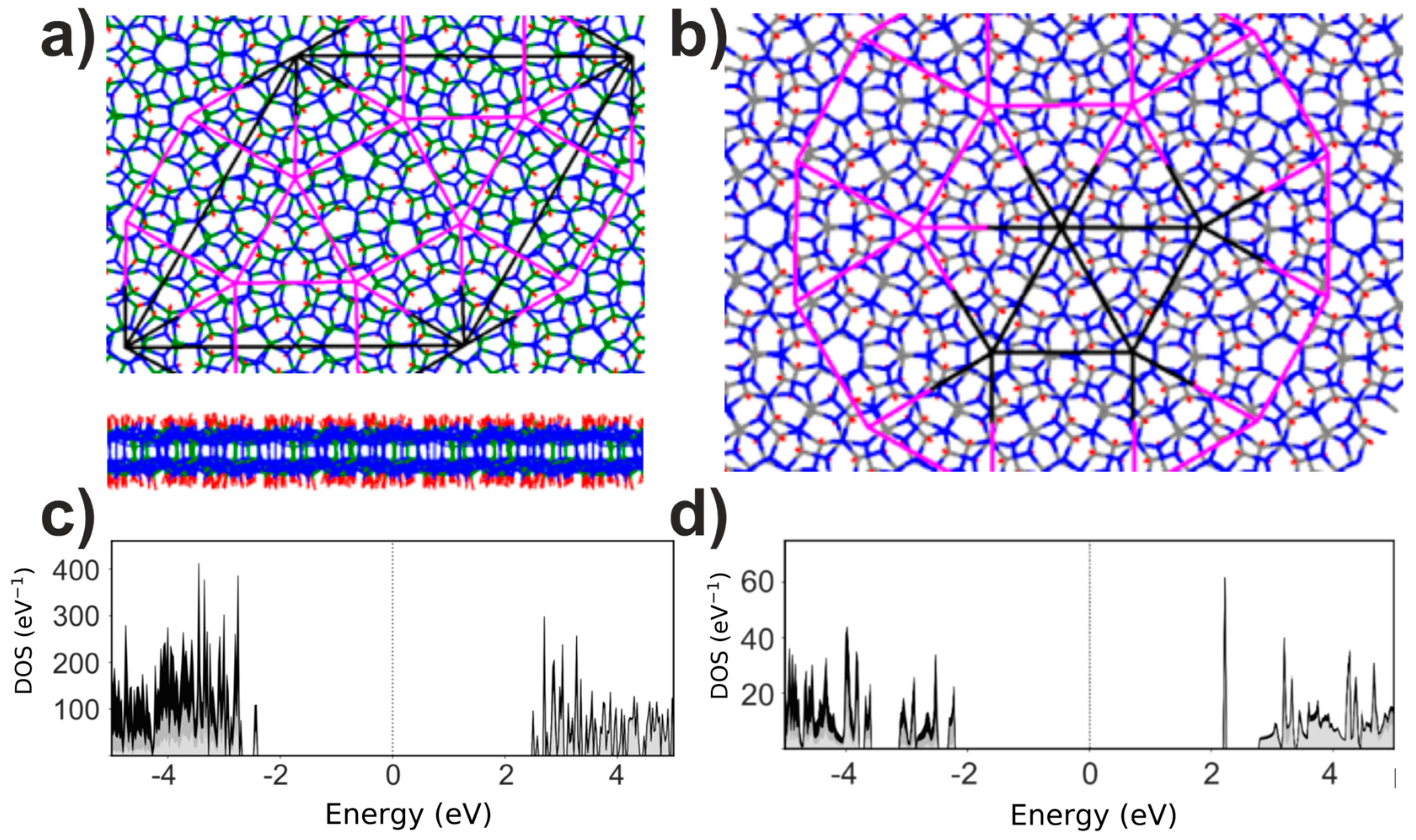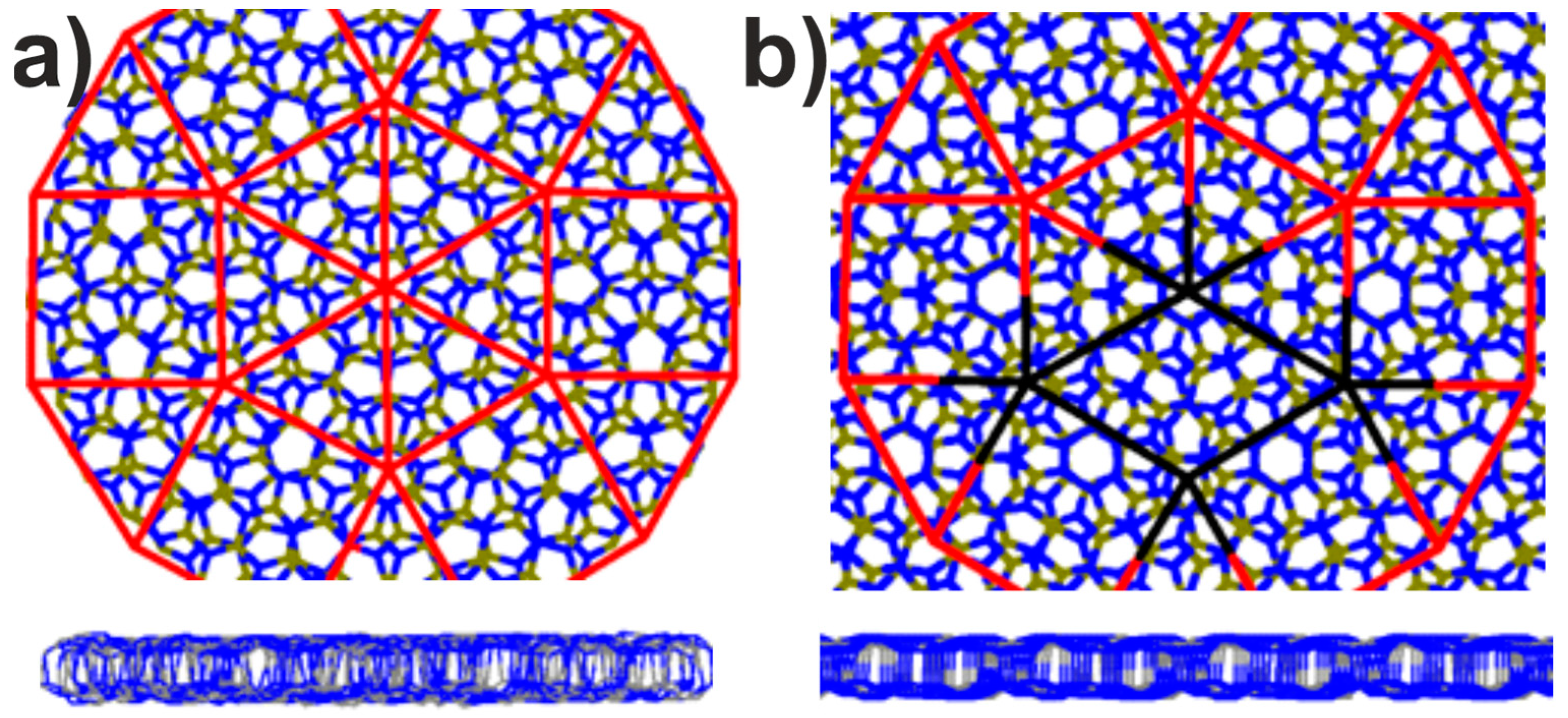BN Diamane-like Quasicrystal Based on 30° Twisted H-BN Bilayers and Its Approximants: Features of the Atomic Structure and Electronic Properties
Abstract
1. Introduction
2. Computational Methodology
3. Results and Discussion
3.1. Atomic Structure of 2D Diamane-like BN Quasicrystal
3.2. The Building Blocks of the 2D Structure Assembled with the Reconstructed Stampfli Tiling
3.3. BNn29.4 and BNn27.8 Approximants
3.4. Boron-Nitridene Quasicrystal
4. Conclusions
Author Contributions
Funding
Institutional Review Board Statement
Informed Consent Statement
Data Availability Statement
Acknowledgments
Conflicts of Interest
References
- Shechtman, D.; Blech, I.; Gratias, D.; Cahn, J.W. Metallic Phase with Long-Range Orientational Order and No Translational Symmetry. Phys. Rev. Lett. 1984, 53, 1951–1953. [Google Scholar] [CrossRef]
- Yadav, T.P.; Kumbhakar, P.; Mukhopadhyay, N.K.; Galvao, D.S.; Ajayan, P.M.; Ranganathan, S.; Chattopadhyay, K.; SekharTiwary, C. Revisiting Quasicrystals for the Synthesis of 2D Metals. Trans. Indian Inst. Met. 2022, 75, 1093–1100. [Google Scholar] [CrossRef]
- Ahn, S.J.; Moon, P.; Kim, T.-H.; Kim, H.-W.; Shin, H.-C.; Kim, E.H.; Cha, H.W.; Kahng, S.-J.; Kim, P.; Koshino, M.; et al. Dirac electrons in a dodecagonal graphene quasicrystal. Science 2018, 361, 782–786. [Google Scholar] [CrossRef] [PubMed]
- Yao, W.; Wang, E.; Zhang, Y.; Zhang, J.R.; Chan, C.K.; Chen, C.; Avila, J.; Asensio, M.C.; Zhu, J.; Zhou, S. Quasicrystalline 30° twisted bilayer graphene as an incommensurate superlattice with strong interlayer coupling. Proc. Natl. Acad. Sci. USA 2018, 115, 6. [Google Scholar] [CrossRef]
- Chernozatonskii, L.A.; Demin, V.A.; Kvashnin, A.G.; Kvashnin, D.G. Diamane quasicrystals. Appl. Surf. Sci. 2022, 572, 151362. [Google Scholar] [CrossRef]
- Chernozatonskii, L.A.; Sorokin, P.B.; Kvashnin, A.G.; Kvashnin, D.G. Diamond-like C2H nanolayer, diamane: Simulation of the structure and properties. JETP Lett. 2009, 90, 134–138. [Google Scholar] [CrossRef]
- Chernozatonskii, L.A.; Demin, V.A.; Kvashnin, D.G. Fully Hydrogenated and Fluorinated Bigraphenes–Diamanes: Theoretical and Experimental Studies. J. Carbon Res. 2021, 7, 17. [Google Scholar] [CrossRef]
- Bakharev, P.V.; Huang, M.; Saxena, M.; Lee, S.W.; Joo, S.H.; Park, S.O.; Dong, J.; Camacho-Mojica, D.C.; Jin, S.; Kwon, Y.; et al. Chemically Induced Transformation of Chemical Vapour Deposition Grown Bilayer Graphene into Fluorinated Single-Layer Diamond. Nat. Nanotechnol. 2020, 15, 59–66. [Google Scholar] [CrossRef]
- Piazza, F.; Cruz, K.; Monthioux, M.; Puech, P.; Gerber, I. Raman Evidence for the Successful Synthesis of Diamane. Carbon 2020, 169, 129–133. [Google Scholar] [CrossRef]
- Barboza, A.P.M.; Guimaraes, M.H.D.; Massote, D.V.P.; Campos, L.C.; Neto, N.M.B.; Cancado, L.G.; Lacerda, R.G.; Chacham, H.; Mazzoni, M.S.C.; Neves, B.R.A. Room-Temperature Compression-Induced Diamondization of Few-Layer Graphene. Adv. Mater. 2011, 23, 3014–3017. [Google Scholar] [CrossRef]
- Gao, Y.; Cao, T.; Cellini, F.; Berger, C.; de Heer, W.A.; Tosatti, E.; Riedo, E.; Bongiorno, A. Ultrahard carbon film from epitaxial two-layer graphene. Nat. Nanotech. 2018, 13, 133–138. [Google Scholar] [CrossRef]
- Ke, F.; Zhang, L.; Chen, Y.; Yin, K.; Wang, C.; Tzeng, Y.-K.; Lin, Y.; Dong, H.; Liu, Z.; Tse, J.S.; et al. Synthesis of Atomically Thin Hexagonal Diamond with Compression. Nano Lett. 2020, 20, 5916–5921. [Google Scholar] [CrossRef] [PubMed]
- Cellini, F.; Lavini, F.; Cao, T.; de Heer, W.; Berger, C.; Bongiorno, A.; Riedo, E. Epitaxial Two-Layer Graphene under Pressure: Diamene Stiffer than Diamond. FlatChem 2018, 10, 8–13. [Google Scholar] [CrossRef]
- Chernozatonskii, L.A.; Demin, V.A.; Kvashnin, D.G. Ultrawide-bandgap Moiré diamanes based on bigraphenes with the twist angles Θ∼ 30°. Appl. Phys. Lett. 2020, 117, 253104. [Google Scholar] [CrossRef]
- Chowdhury, S.; Demin, V.A.; Chernozatonskii, L.A.; Kvashnin, D.G. Ultra-Low Thermal Conductivity of Moiré Diamanes. Membranes 2022, 12, 925. [Google Scholar] [CrossRef] [PubMed]
- Angizi, S.; Alem, S.A.A.; Azar, M.H.; Shayeganfar, F.; Manning, M.I.; Hatamie, A.; Pakdel, A.; Simchi, A. A comprehensive review on planar boron nitride nanomaterials: From 2D nanosheets towards 0D quantum dots. Prog. Mater. Sci. 2022, 124, 100884. [Google Scholar] [CrossRef]
- Demin, V.; Chernozatonskii, L. Diamane-like Films Based on Twisted G/BN Bilayers: DFT: Modelling of Atomic Structures and Electronic Properties. Nanomaterials 2023, 13, 841. [Google Scholar] [CrossRef]
- Zhang, Z.; Zeng, X.C.; Guo, W. Fluorinating Hexagonal Boron Nitride into Diamond-Like Nanofilms with Tunable Band Gap and Ferromagnetism. J. Am. Chem. Soc. 2011, 133, 14831–14838. [Google Scholar] [CrossRef]
- Chernozatonskii, L.A.; Katin, K.P.; Kochaev, A.I.; Maslov, M.M. Moiré and non-twisted sp3-hybridized structures based on hexagonal boron nitride bilayers: Ab initio insight into infrared and Raman spectra, bands structures and mechanical properties. Appl. Surf. Sci. 2022, 606, 154909. [Google Scholar] [CrossRef]
- Han, Z.; Zhang, R.; Li, M.; Li, L.; Geng, D.; Hu, W. Recent advances in the controlled chemical vapor deposition growth of bilayer 2D single crystals. J. Mater. Chem. C 2022, 10, 13324. [Google Scholar] [CrossRef]
- Kim, S.M.; Hsu, A.; Park, M.H.; Chae, S.H.; Yun, S.J.; Lee, J.S.; Cho, D.H.; Fang, W.; Lee, C.; Palacios, T.; et al. Synthesis of large-area multilayer hexagonal boron nitride for high material performance. Nat. Commun. 2015, 6, 8662. [Google Scholar] [CrossRef] [PubMed]
- Momma, K.; Izumi, F. VESTA: A Three-Dimensional Visualization System for Electronic and Structural Analysis. J. Appl. Crystallogr. 2008, 41, 653–658. [Google Scholar] [CrossRef]
- Smidstrup, S.; Markussen, T.; Vancraeyveld, P.; Wellendorff, J.; Schneider, J.; Gunst, T.; Verstichel, B.; Stradi, D.; Khomyakov, P.A.; Vej-Hansen, U.G.; et al. QuantumATK: An integrated platform of electronic and atomic-scale modelling tools. J. Phys. Cond. Mat. 2019, 32, 015901. [Google Scholar] [CrossRef] [PubMed]
- Perdew, J.P.; Burke, K.; Ernzerhof, M. Generalized Gradient Approximation Made Simple. Phys. Rev. Lett. 1996, 77, 3865. [Google Scholar] [CrossRef] [PubMed]
- Grimme, S. Semiempirical GGA-type density functional constructed with a long-range dispersion correction. J. Comput. Chem. 2006, 27, 1787–1799. [Google Scholar] [CrossRef]
- Kochaev, A.I. Hypothetical planar and nanotubular crystalline structures with five interatomic bonds of Kepler nets type. AIP Adv. 2017, 7, 025202. [Google Scholar] [CrossRef]
- Stampfli, P. A Dodecagonal Quasiperiodic Lattice in Two Dimensions. Helv. Phys. Acta 1986, 56, 1260–1263. [Google Scholar]
- Chernozatonskii, L.A.; Katin, K.P.; Demin, V.A.; Maslov, M.M. Moiré diamanes based on the hydrogenated or fluorinated twisted bigraphene: The features of atomic and electronic structures, Raman and infrared spectra. Appl. Surf. Sci. 2021, 537, 148011. [Google Scholar] [CrossRef]
- Schenk, S.; Krahn, O.; Cockayne, E.; Meyerheim, H.L. 2D honeycomb transformation into dodecagonal quasicrystals driven by electrostatic forces. Nat. Commun. 2022, 13, 7542. [Google Scholar] [CrossRef]
- Chernozatonskii, L.A.; Demin, V.A.; Kvashnin, D.G. Moiré Diamones: New Diamond-like Films of Semifunctionalized Twisted Graphene Layers. J. Phys. Chem. Lett. 2022, 13, 5399–5404. [Google Scholar] [CrossRef]
- Brazhe, R.; Kochaev, A.; Sovetkin, A. Piezoelectric Effect in Graphene-Like 2D Supracrystals with a Periodic Perforation Breaking the Central Symmetry. Phys. Solid State 2013, 55, 1925. [Google Scholar] [CrossRef]
- Brazhe, R.; Kochaev, A.; Sovetkin, A. Piezoelectric Effect in Fluorographane-Like 2D Supracrystals. Phys. Solid State 2013, 55, 2094. [Google Scholar] [CrossRef]
- Leconte, N.; Park, Y.; An, J.; Jung, J. Commensuration torques and lubricity in double Moire systems. arXiv 2023, arXiv:2301.04105. [Google Scholar]





Disclaimer/Publisher’s Note: The statements, opinions and data contained in all publications are solely those of the individual author(s) and contributor(s) and not of MDPI and/or the editor(s). MDPI and/or the editor(s) disclaim responsibility for any injury to people or property resulting from any ideas, methods, instructions or products referred to in the content. |
© 2023 by the authors. Licensee MDPI, Basel, Switzerland. This article is an open access article distributed under the terms and conditions of the Creative Commons Attribution (CC BY) license (https://creativecommons.org/licenses/by/4.0/).
Share and Cite
Chernozatonskii, L.A.; Kochaev, A.I. BN Diamane-like Quasicrystal Based on 30° Twisted H-BN Bilayers and Its Approximants: Features of the Atomic Structure and Electronic Properties. Crystals 2023, 13, 421. https://doi.org/10.3390/cryst13030421
Chernozatonskii LA, Kochaev AI. BN Diamane-like Quasicrystal Based on 30° Twisted H-BN Bilayers and Its Approximants: Features of the Atomic Structure and Electronic Properties. Crystals. 2023; 13(3):421. https://doi.org/10.3390/cryst13030421
Chicago/Turabian StyleChernozatonskii, Leonid A., and Aleksey I. Kochaev. 2023. "BN Diamane-like Quasicrystal Based on 30° Twisted H-BN Bilayers and Its Approximants: Features of the Atomic Structure and Electronic Properties" Crystals 13, no. 3: 421. https://doi.org/10.3390/cryst13030421
APA StyleChernozatonskii, L. A., & Kochaev, A. I. (2023). BN Diamane-like Quasicrystal Based on 30° Twisted H-BN Bilayers and Its Approximants: Features of the Atomic Structure and Electronic Properties. Crystals, 13(3), 421. https://doi.org/10.3390/cryst13030421





